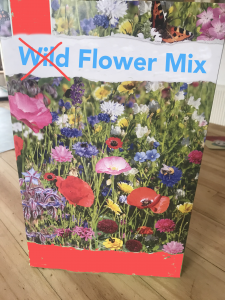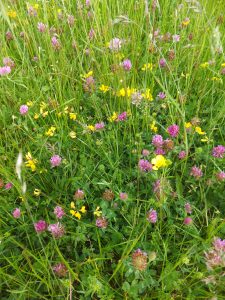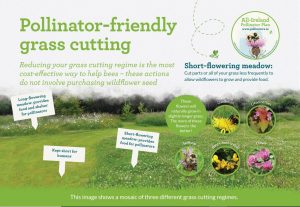Botanist Dr Noeleen Smyth explains why the word ‘wild’ should be removed from those ubiquitous wildflower seed packets popping up in every store
Spring fever has gripped, I have just moved house, and am full of enthusiasm for my new space and the joys of spring, with that “grand stretch” in the evening. I have been out in search of rugs and mugs in the local retail park, and as the only stores open in my 5km, I have been there way to often over the last few weeks. I have been looking at what is for sale and the home and garden fashions of spring 2021.
What I have discovered has shocked me. As with all fashions, the faces and bodies on sales displays rarely exist in the real world. When did “fake” become the dream and the selling point for everything?
While I grapple for an item with its advertised picture perfection, be it face, body, clothes or home accessory, I know the sale pitches. I am well used to utopian dreams and reality, but now “fake” has stretched further to invade the Gardening section and its shelves of seed.
Here, “fake” is totally pouring, spilling and spoiling our vision of the wild, skewing reality with its pictures of “fake” frothy flower meadows. The few and last remaining patches of wild earth, which exist at the fringes of our society, should be seen as perfectly fine, but now apparently also need this flash improvement.
If seed was labelled correctly, customers would understand that these
flowers should remain confined to private garden pots.
One packet, very enticingly covered with dabs of oranges and blues, is entitled “wildflower mix”. Having spent most of my life as a plants person in various parts of the world with wild flowers, the pictures on these packets do not resemble any place I have ever been to, at home or abroad, in the last 25 years.
The blue on the packet I identify as Cornflower is a relic of the past, as a former weed of cereal and flax fields, now both almost extinct in Ireland. Cornflower (Centaurea cyanus) is now most frequent on rubbish tips as a casual arising from gardens and wildflower seed mixtures; thus, it appears we are perpetuating and polluting any remaining wild cornflowers with our shiny new packets of cornflowers originating from who knows where. The packets in many instances don’t give any origin.
The splash of red on the same packet of “Wildflower mix” is a plant I used to love growing as an exotic hardy annual in the display beds at the National Botanic Gardens – Scarlet flax (Linum grandiflorum), not to be found in any wildflower area I have ever seen in Ireland, as it is native to Algeria and Southern Europe.
The orange colour in the same packet is Pot Marigold (Calendula officinalis). For this species, at this stage, who even knows where it ever really existed or could be found in the wild? It is reputed to be a southern European species, but humans have been cultivating it and its many forms for so many years now that we have no real idea where it ever originated. So, there you go, that is our packet of “Wildflowers mixed”. Oh yes, they are mixed all right, it is a right old mix of nothing ‘wild’ but a flamboyant and utopian floral kingdom that does not exist.
The next packet that I spot on the shelf has me muttering to myself in a very colourful version of one of Victor Meldrew’s favourite sayings, “I don’t believe it”. The packet that outraged me was labelled “Flower Biodiversity mix”, the picture in this case had the aforementioned cornflowers in various luminous hues of blues and pinks. Added to the cornflower in this case is what looks like Borage (Borago officinalis), a native of the Mediterranean. Another frequenter of rubbish tips and waste ground, when we grow tired of them, after they have become a bit too rampant in the garden, out they go to spread into the wild and the places which actually support our real floral biodiversity and which most urgently needs our care and protection. What annoyed me most about this packet is that the people interested in buying this product really do want to do something genuine for biodiversity, but are being duped through false marketing.
What annoyed me most about this packet
is that the people interested in buying this product
really do want to do something genuine for biodiversity,
but are being duped through false marketing.
The next two packets I looked at were also floral abominations, very falsely labelled “Field flowers” and “Meadow flowers”. The field flower pack had Cosmos (Cosmos bipinnatus), oh yes, indeed this species might be found in a field, but those fields are in Mexico.
The “Meadow flowers” packet highlighted Corncockle (Agrostemma githago), which has or never was found in meadows but in the wheat fields of the past, where they disappeared from after we started to clean wheat seed better when the Corncockle seed poisoned us.
When I finally make it out of the retail park – in need of some air – I go for cycle on a newly installed cycle track between Portmarnock and Baldoyle, where the remnants of last summer’s sown “Biodiversity” mix abominations are waiting to sprout again… more Meldrew muttering. This planted mix is totally ousting what would naturally have become a stunning clover, grass and wild carrot coastal mix, which grows very naturally and is stunning by the nearby footpath. A few seeds gathered from this local patch would have been perfect .
When I cannot stomach any more, I return home via a grass verge “planted” by the local well-meaning residents near my housing estate as pollinator friendly planting, also heaving with the “Biodiversity mix” of fake flora i.e. the flora of Algeria, Mexico and somewhere in the Mediterranean. I think the bees and other pollinators are as befuddled and confused as I am at this stage. They are happy enough with the local hedgerows, semi natural and natural grass areas and especially Dandelions (Taraxacum spp.) this early in the year.
The All-Ireland Pollinator Plan (AIPP) really highlights that “Wildflower” mixes. such as these crazy floral abominations. should not be planted into natural or semi-natural habitats. If you really want their fake flamboyance in your garden, go for it. The AIPP have developed some excellent guidance documents for every situation from gardens to golf courses and all the information can be found on the website (pollinators.ie).
Natural native meadows developed through reduced mowing are better for biodiversity
From what I have seen for sale so far this year, I think you should know that you are being duped and buying this seed will do nothing for biodiversity, wildflowers, fields, meadows or bees. These are all naturally adapted to our existing wild plants and places. Though bees and butterflies often enjoy the exotic delights of our gardens, gardens are not the places they rely on to thrive. At the National Botanic Gardens, we grow over 17,000 exotic species to showcase them in a garden setting and we also grow many bee-friendly border plants, but we don’t let them outside the gate. Growing these packets of seed in the wild is the equivalent of applying the Donald Trump shade of fake tan to your child’s skin in summer and thinking they look way better.
Some people say they have gone to lengths to track Irish wildflower seed for their area and I say more power to you, but please look again at the species mix on the packet, do they really exist or exist in that combination anywhere in Ireland? A quick way to tell is if you see too many luminous splashes of colour – especially the blue or pink cornflowers – as you are not getting anything that has any origin in Ireland as a native Irish wildflower.
Feel free to send any queries or mixes to the National Botanic Gardens, and we will be happy to give you our informed opinion. We know of just one, maybe two, suppliers that we think are selling genuinely harvested Irish Wildflower seed, as for the rest ….well it is more expletives. Some companies are also very clever in marketing their product, but now you know better and are able to ask the all-important questions, such as, where in Ireland do they grow and where were they harvested?
If you really want to do something in your garden for biodiversity, read the guides from the All-Ireland Pollinator Plan, take a very long lie down, and enjoy your own garden. If it is filled with Dandelions and Clover, great, the bees will love it, and yes, please do plant some nice pollinator-friendly plants as outlined on the AIPP website. My final plea is to not go near those “wildflower” packets thinking they are anything other than a made-up vision, or spread them in the wonderful wild that already exists outside our garden gates.
Let your motto be “Don’t mow, let it grow” and let’s support the
remaining verges as fringes of Irish wildflowers and biodiversity.
Irish wildflower meadows have disappeared by 97%.
Some of the remnants of these old meadows are on our roadside verges.
By Noeleen Smyth PhD, Conservation Botanist,
National Botanic Gardens, Glasnevin, Dublin 9
Email: [email protected]
Further Reading:
https://pollinators.ie/debunking-some-myths-about-bees/
https://pollinators.ie/practical-advice-on-managing-wildflower-meadows/
https://pollinators.ie/reducing-mowing-for-pollinators-brilliant-for-bees-harder-for-humans/
To find out more, see our videos on creating natural meadows through reduced mowing: https://pollinators.ie/videos/
Creating Meadows for Biodiversity
Top Tips for Creating a Wildflower Meadow




